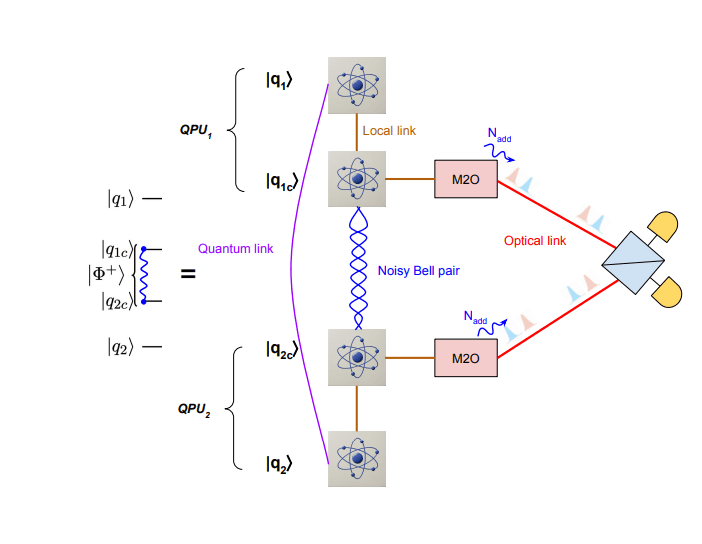Distributed quantum computation promises to overcome the limitations of current quantum processors, but efficiently connecting these modules remains a significant challenge. Shobhit Gupta, Nikolay Sheshko, and Daniel J. Dilley, alongside Alvin Gonzales, Manish K. Singh, and Zain H. Saleem, investigate two leading approaches to this problem: gate teleportation and circuit cutting. Their work demonstrates that while circuit cutting currently dominates, gate teleportation offers a pathway to significantly reduce computational overhead, particularly when generating complex multipartite entangled states. The team models the performance of remote gates using noisy quantum interconnects and identifies specific improvements in hardware, such as a ten-fold reduction in transducer noise, that would make gate teleportation a more efficient strategy than repeatedly dividing and reassembling quantum circuits. This research informs the development of near-term quantum interconnects and advocates for a hybrid approach to distributed computation, intelligently combining both quantum links and circuit cuts to minimise overall runtime.
Modular Quantum Computing and Scalability
Quantum computing faces a significant challenge: building processors large enough to solve complex problems. Researchers are now exploring modular quantum computing, a strategy that connects smaller quantum processing units (QPUs) to create a more powerful, scalable system. This approach overcomes the limitations of constructing a single, massive quantum computer, offering a viable path towards practical quantum computation. Key to this strategy is developing effective interconnects between these modules, allowing quantum information to be shared and processed across the network. Several approaches are being investigated to achieve this connectivity, including microwave-optical transducers, direct qubit connections, and photonic interconnects.
Scientists are also developing communication protocols and error correction techniques tailored for these distributed systems. A central technique in this field is circuit cutting, where a large quantum circuit is broken down into smaller sub-circuits executed on different QPUs, with optimization focused on partitioning circuits and mitigating errors. Researchers are employing quantum teleportation and developing specialized error correction codes to maintain data integrity across multiple modules. The hardware underpinning this modularity relies heavily on superconducting qubits, photonic integration, and optomechanical systems. Software tools, including Qiskit extensions and circuit knitting toolboxes, are being developed to facilitate the implementation and simulation of distributed quantum algorithms, with potential applications in quantum machine learning, quantum chemistry, and general-purpose quantum computation.
Remote Gate and Circuit Cutting Comparison
Scientists are comparing remote gate teleportation and circuit cutting to determine which excels under different conditions for distributed quantum computation. They developed a simulation framework to model the fidelity of entangled states, specifically Greenberger-Horne-Zeilinger (GHZ) states, generated between quantum processing units (QPUs). This analysis focuses on the performance of intermodule CNOT gates, crucial for creating multipartite entangled states distributed across processor modules. Remote gates are implemented using the TeleGate primitive, utilizing shared entangled pairs between communication qubits across modules alongside local operations.
The quantum link relies on microwave-to-optical (M2O) transducers, upconverting microwave photons to optical photons for transmission over optical fiber. Entanglement between communication qubits is optically heralded, enabling the implementation of remote gates between data qubits. Researchers meticulously modeled the noise introduced by these M2O transducers, recognizing that transducer performance is the primary bottleneck for achieving high-fidelity entanglement. By evaluating the fidelity of GHZ states as a function of this noise, researchers can directly compare the performance with circuit cutting, where fidelity degrades exponentially with the number of cuts. This detailed modeling allows for the identification of break-even points where remote gates achieve parity with circuit cutting, particularly for generating complex multipartite entangled states.
Remote Gates and Circuit Cuts Compared
Researchers are demonstrating a pathway for distributed quantum computation, exploring methods to overcome the limitations of single quantum processors. Their work focuses on comparing remote gate teleportation and circuit cutting, with the goal of executing larger quantum circuits than currently possible. Experiments involved simulating the generation of Greenberger-Horne-Zeilinger (GHZ) states between processor modules using both remote gates and circuit cuts. The team measured the Hellinger fidelity to assess the impact of errors on each approach, revealing that the performance of remote gates and circuit cuts are comparable but depend heavily on the primary source of error for each method.
Detailed analysis reveals that a ten-fold reduction in the noise added by M2O transducers would favor generating multipartite entangled states using remote gates over circuit cutting, stemming from the exponential sampling overhead inherent in circuit cutting. Specifically, the team determined that minimizing the sampling cost of circuit decomposition is crucial for optimizing circuit cutting performance. To accurately assess performance, researchers developed a method to reconstruct probabilities from local measurements, enabling the calculation of Hellinger fidelity for complex circuits.
Remote Gate Teleportation, Fidelity and Noise Limits
This research demonstrates the feasibility of distributing quantum computations across separate processor modules using entanglement-based gate teleportation, offering a potential pathway beyond the limitations of single-processor architectures. By modeling noisy remote gates and comparing their performance to traditional circuit cutting techniques, scientists have identified conditions under which quantum links can achieve comparable fidelity. The team’s analysis establishes a clear relationship between transducer noise and the viability of remote gates, suggesting that a ten-fold reduction in current noise figures would significantly improve the fidelity of multipartite entangled states. This finding highlights the importance of advancements in quantum interconnect hardware and motivates a network-aware computational strategy that leverages the strengths of both quantum and classical methods. While acknowledging the impact of transducer noise and circuit size on gate fidelity, the researchers note that their noise model is broadly applicable to various qubit modalities interconnected with noisy frequency converters. Future work will expand this model to incorporate additional qubit-specific noise sources and explore alternative entanglement generation protocols, further refining the understanding of distributed quantum computation.

